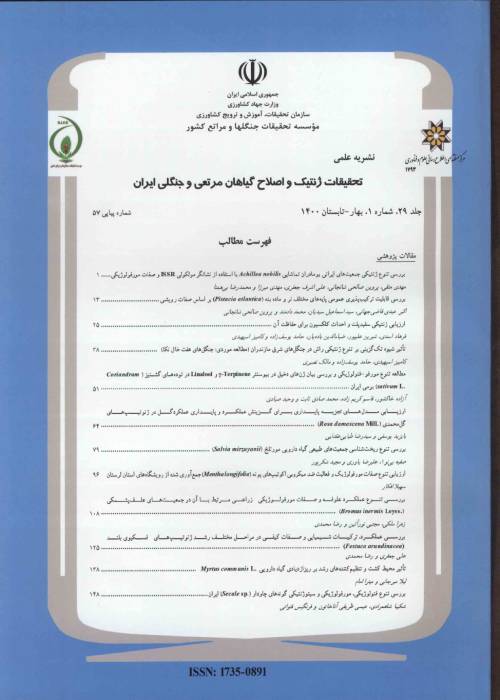Karyotypic study on six populations of species and subspecies of Burnet genera (Sanguisorba ssp.)
Author(s):
Abstract:
The research was carried out to study biodiversity aspects of six small burnet populations, using cytogenetic traits. Root tips were stained; and chromosom morphological traits such as short arm length (SA), long arm length (LA) and total length (TL) were measured using photomicroscope and Micromeasure software. Analysis of variances was performed on chromosomes morphological traits: LA, SA, TL, arm ratio (AR) and centromer index (CI), using unbalanced completely randomized design with at least three replications. Several symmetrical assessment statistics such as: relative length of the shortest chromosome (S%), total form percentage (TF%), A1, difference of relative length range (DRL), A2, Levans chromosomal nomenclature method and Stebbins categories (SC) were calculated. Results showed that populations number 10462, 13976 and kangalchal populations were tetraploid (2n=4x=28) while population number 12333 was hexaploid (2n=6x=42), and populations number 13963 and 13296 were octaploid (2n=8x=56). Populations 13296 (octaploid) and 13976 (tetraploid) showed the most asymmetric karyotype between the studied populations base on A2 and DRL. Populations 13963 (octaploid) and 13976 (tetraploid) showed the most asymmetric karyotype between all of the studied populations base on %TF and A1. Using principal components analysis, the first three components justified % 99.7 of the total variance. In the first component, SA and TL with the highest coefficients of eigen vectors, were the most important traits. In the second component, LA, AR, CI, %TF and A1 had the most important role. In the third component, %S, DRL and A2 were the most important traits. Cluster Analysis classified the population in three clusters when clustering was performed based on karyotypic statistics. Clustering revieled that the octoploid population, 13296 had the most genetic distance with 13976 octaploid papulations. According to the scater plot, base on the first two components, the populations were grouped in three distinct classes, corresponding with the result of cluster analysis.
Language:
Persian
Published:
Iranian Journal of Rangelands Forests Plant Breeding and Genetic Research, Volume:19 Issue: 1, 2011
Page:
119
magiran.com/p913321
دانلود و مطالعه متن این مقاله با یکی از روشهای زیر امکان پذیر است:
اشتراک شخصی
با عضویت و پرداخت آنلاین حق اشتراک یکساله به مبلغ 1,390,000ريال میتوانید 70 عنوان مطلب دانلود کنید!
اشتراک سازمانی
به کتابخانه دانشگاه یا محل کار خود پیشنهاد کنید تا اشتراک سازمانی این پایگاه را برای دسترسی نامحدود همه کاربران به متن مطالب تهیه نمایند!
توجه!
- حق عضویت دریافتی صرف حمایت از نشریات عضو و نگهداری، تکمیل و توسعه مگیران میشود.
- پرداخت حق اشتراک و دانلود مقالات اجازه بازنشر آن در سایر رسانههای چاپی و دیجیتال را به کاربر نمیدهد.
In order to view content subscription is required
Personal subscription
Subscribe magiran.com for 70 € euros via PayPal and download 70 articles during a year.
Organization subscription
Please contact us to subscribe your university or library for unlimited access!


